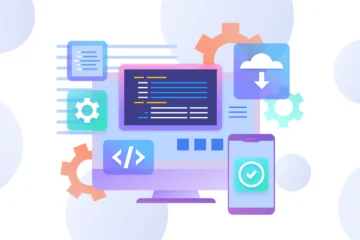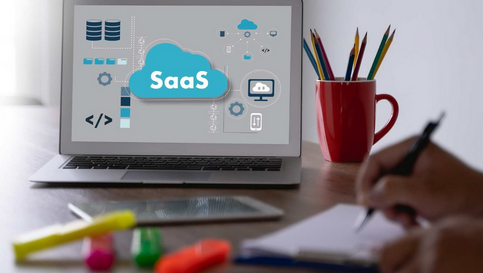Small businesses face significant challenges when attempting to stand out from well-established large corporations in today’s highly competitive market. However, with the widespread adoption of mobile app technology, small businesses are discovering powerful tools to level the playing field.
Mobile apps not only enhance visibility but also enable personalized customer experiences, efficient operations, and innovative marketing strategies. Take a look at how small businesses can leverage mobile apps to gain a competitive edge.
What are the Benefits of Mobile App Development for Small Businesses?
1. Enhanced Customer Engagement and Retention
One of the biggest advantages of mobile app development for small businesses is the ability to create personalized customer experiences. Unlike traditional websites or social media platforms, apps allow small businesses to deliver personalized experiences through:
- Push Notifications: Keeping customers informed about promotions, discounts, or updates in real time.
- Loyalty Programs: Offering exclusive rewards and incentives to encourage repeat purchases and increase customer loyalty.
- Customized Content: Tailoring recommendations and messaging based on user behavior and preferences.
For example, a local coffee shop can use its app to notify customers of happy hours or provide a reward after a certain number of purchases, ensuring customer retention in a cost-effective way.

2. Leveling the Playing Field with Advanced Analytics
Mobile apps provide real-time data on customer behavior, enabling small businesses to make informed decisions. According to Statista, the global big data market is forecasted to grow to $103 billion by 2027, more than double its expected market size in 2018.
With a share of 45%, the software segment is expected to become the largest big data market segment by 2027. This growth highlights how accessible and impactful analytics tools can be for empowering small businesses.
Key metrics such as:
- Customer Lifetime Value (CLV): Identifying long-term loyal customers.
- Churn Rates: Pinpointing areas for improvement to retain users.
- Engagement Metrics: Monitoring in-app activity to refine user experiences.
Through the power of mobile app development, small businesses can analyze this data to optimize their offerings, giving them the same data-driven edge that big brands enjoy.
3. Cost-Effective Marketing and Brand Visibility
Big brands often dominate traditional advertising channels, but mobile app development enables small businesses to engage customers directly and affordably. With a dedicated app, businesses can deploy targeted marketing strategies that resonate with their audience.
Examples of Mobile App Marketing Strategies:
- Referral Programs: Encouraging existing users to bring new customers through incentives.
- In-App Promotions: Showcasing exclusive deals to app users.
- Social Media Integration: Enabling seamless sharing of offers and app-related content.
Moreover, having a presence in app stores increases visibility. When potential customers search for solutions in a specific niche, your app stands as a beacon of accessibility.

4. Improved Customer Support and Satisfaction
Mobile apps make it easier for small businesses to provide efficient and effective customer support. Unlike big brands, small businesses can offer personalized interactions and quick resolutions to customer issues. Key features include:
- Chatbots: Offering instant answers to frequently asked questions.
- Ticketing Systems: Ensuring timely responses to complaints or queries.
- Feedback Channels: Gathering reviews to enhance services and build trust.
For example, a boutique store with a mobile app can handle post-purchase support directly within the app, providing a seamless experience that strengthens customer satisfaction.
Tip: Looking for a way to grow your business with a high-quality mobile or web app? At App-Scoop, we specialize in crafting polished apps for iPhone, Android, and the Web, enabling small businesses to compete with larger brands.
As a top mobile and web app development company in Canada and the USA, we are trusted by enterprises, high-growth startups, and businesses to bring their app ideas to life. Contact us today to find out how we can assist you with your app development project and drive business growth.
5. Streamlined Operations Through Mobile App Development
Efficiency is a critical factor for small businesses with limited resources, and mobile app development offers tools to streamline operations. By automating key processes, businesses can save time and reduce costs.
Functionalities to Optimize Operations:
- Inventory Management: Real-time tracking of stock levels and restocking alerts.
- Scheduling Tools: Managing employee shifts or customer appointments seamlessly.
- Payment Gateways: Providing secure and diverse payment options for faster transactions.
By integrating these functionalities into their apps, small businesses can enhance productivity and compete with the operational precision of larger competitors.
Related Articles:
- Top Frameworks for Cross-Platform Mobile App Development in 2025
- AI-Based Security Solutions for Mobile Apps
- How to Build Offline Mobile Apps?
6. Building Brand Identity and Trust
For small businesses, establishing a strong brand presence is essential for gaining customer trust. A mobile app can act as a brand ambassador, showcasing unique values and offerings. Features like consistent branding elements, interactive interfaces, and user-centric designs can help small businesses stand out.
Apps also offer a platform to gather user reviews and testimonials, which build credibility. Positive customer experiences shared on the app can influence potential customers to trust and engage with the brand.
7. Access to Global Markets
Thanks to mobile app development, small businesses no longer need to limit themselves to local markets. Apps break geographical barriers, enabling companies to reach global audiences without incurring exorbitant costs.
For example, an artisan selling handmade crafts can use an app to showcase and sell their products internationally, leveraging features like multi-language support and currency conversion tools.
8. Adopting Emerging Technologies
Integrating emerging technologies such as Artificial Intelligence (AI), Augmented Reality (AR), and Blockchain into mobile apps allows small businesses to stay ahead of the curve. These technologies, once exclusive to big brands, are now accessible to smaller players, enabling innovation in customer interaction and business processes.

Examples:
- AI-Driven Recommendations: Offering personalized product suggestions to customers.
- AR for Product Demos: Enhancing the shopping experience by allowing customers to visualize products in their environment.
- Blockchain for Secure Payments: Building customer trust with transparent and secure transaction systems.
- Chatbots: Offer instant responses to frequently asked questions.
With mobile app development, small businesses can create support systems that make customers feel valued and heard, strengthening loyalty.
Mobile apps are indispensable for small businesses aiming to compete with big brands. From personalized customer engagement to streamlined operations, mobile apps provide the tools needed to succeed in today’s competitive environment. By harnessing the power of apps, small businesses can create meaningful connections with customers, enhance operational efficiency, and achieve sustained growth.
Frequently Asked Questions
How can a mobile app help a small business compete with larger brands?
A mobile app allows small businesses to provide a personalized customer experience, streamline operations, and engage with customers more effectively. By offering convenience, exclusive deals, and enhanced services, mobile apps enable small businesses to compete with big brands on a more level playing field.
What role does branding play for small businesses with mobile apps?
Mobile apps help small businesses strengthen their brand identity by offering a direct channel to communicate with customers. Customizable design and features allow businesses to showcase their brand’s personality, values, and unique offerings, creating a strong and recognizable presence in the marketplace.
How can mobile apps improve customer engagement for small businesses?
Mobile apps improve customer engagement by offering features like push notifications, personalized promotions, loyalty programs, and in-app messaging. These tools allow businesses to stay connected with customers, keep them informed, and encourage repeat business, all of which enhance long-term loyalty.
Do mobile apps increase customer retention for small businesses?
Yes, mobile apps can significantly improve customer retention. Features such as loyalty rewards, personalized recommendations, and easy access to products or services incentivize customers to return. Additionally, the convenience of using an app for shopping, ordering, or receiving services can boost satisfaction and repeat business.
How do mobile apps provide a competitive advantage for small businesses?
Mobile apps offer small businesses a competitive advantage by enabling them to provide faster service, personalized experiences, and greater convenience. They can help businesses collect valuable customer data, automate tasks, and scale operations, giving them the tools to compete with bigger brands on efficiency and customer experience.
Can mobile apps help small businesses with marketing?
Yes, mobile apps can be a powerful marketing tool. With push notifications, in-app advertisements, and personalized offers, businesses can directly market to their customers. Additionally, apps can help track customer behavior and preferences, enabling small businesses to create targeted marketing campaigns that resonate with their audience.
How can small businesses use mobile apps to improve customer service?
Mobile apps can improve customer service by providing easy access to support features like live chat, FAQs, ticketing systems, and order tracking. These tools enable businesses to respond quickly to customer inquiries, resolve issues more efficiently, and provide better overall service than larger, less responsive brands.
Can small businesses compete with big brands on pricing using mobile apps?
Yes, small businesses can use mobile apps to offer competitive pricing by leveraging features like flash sales, limited-time offers, or special discounts for app users. This helps small businesses provide value in a way that appeals to price-conscious customers while maintaining the flexibility to adapt quickly to market trends.
How do mobile apps enhance small business efficiency?
Mobile apps enhance small business efficiency by automating processes such as inventory management, order fulfillment, appointment scheduling, and payment processing. By streamlining these tasks, businesses can reduce manual labor, improve operational speed, and free up resources to focus on growth and customer engagement.
Are mobile apps cost-effective for small businesses?
Mobile apps can be cost-effective for small businesses, especially when compared to the long-term benefits they provide. While the initial development may require an investment, apps can reduce operational costs, improve marketing ROI, and increase customer retention, ultimately providing a strong return on investment.






































